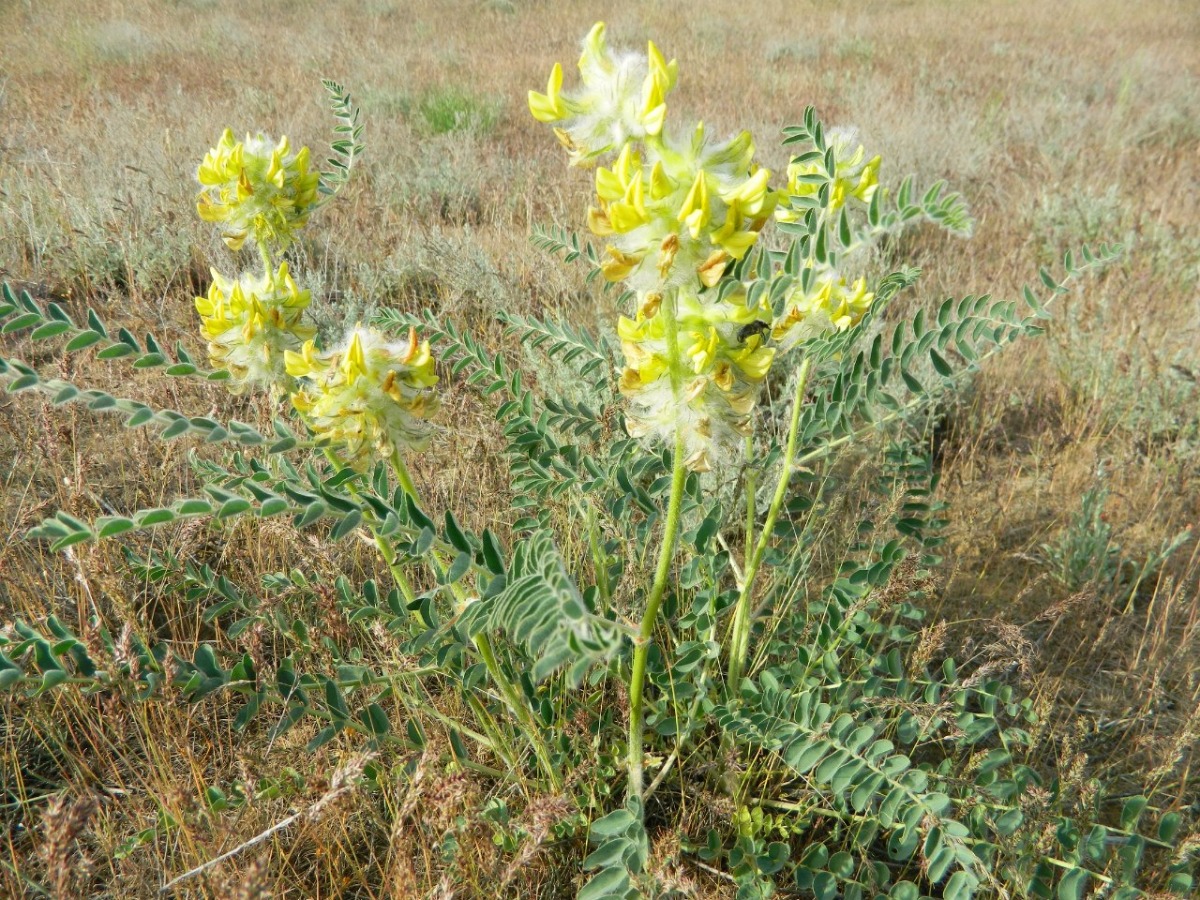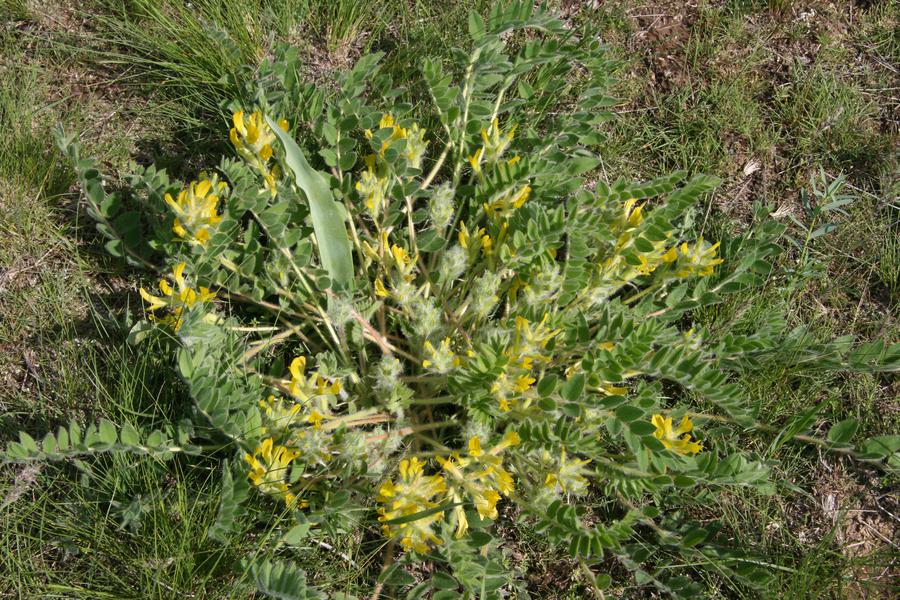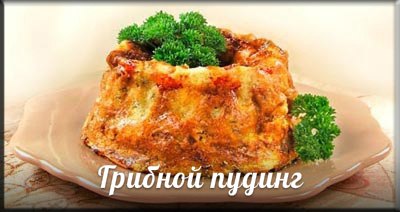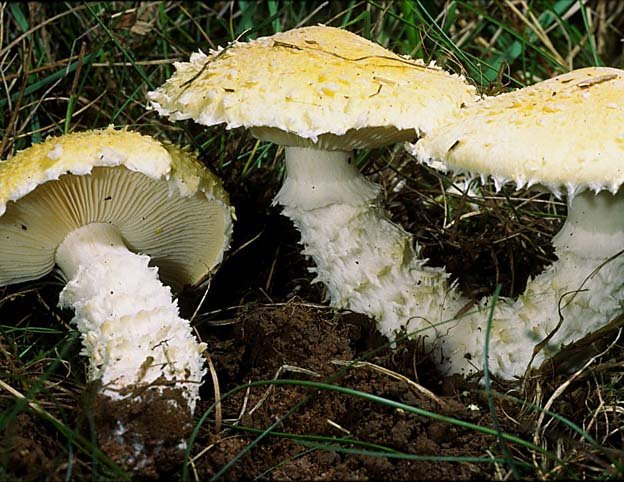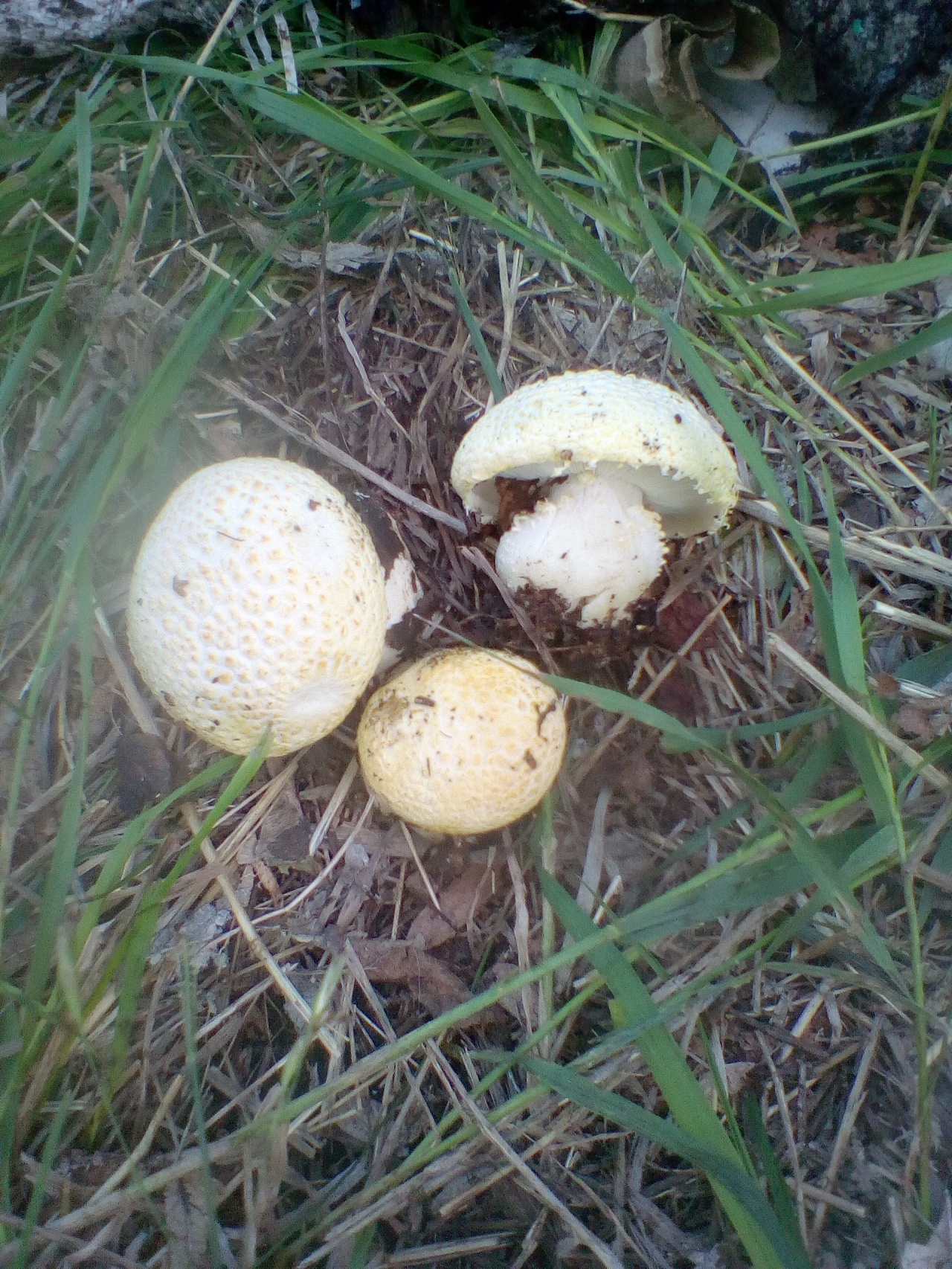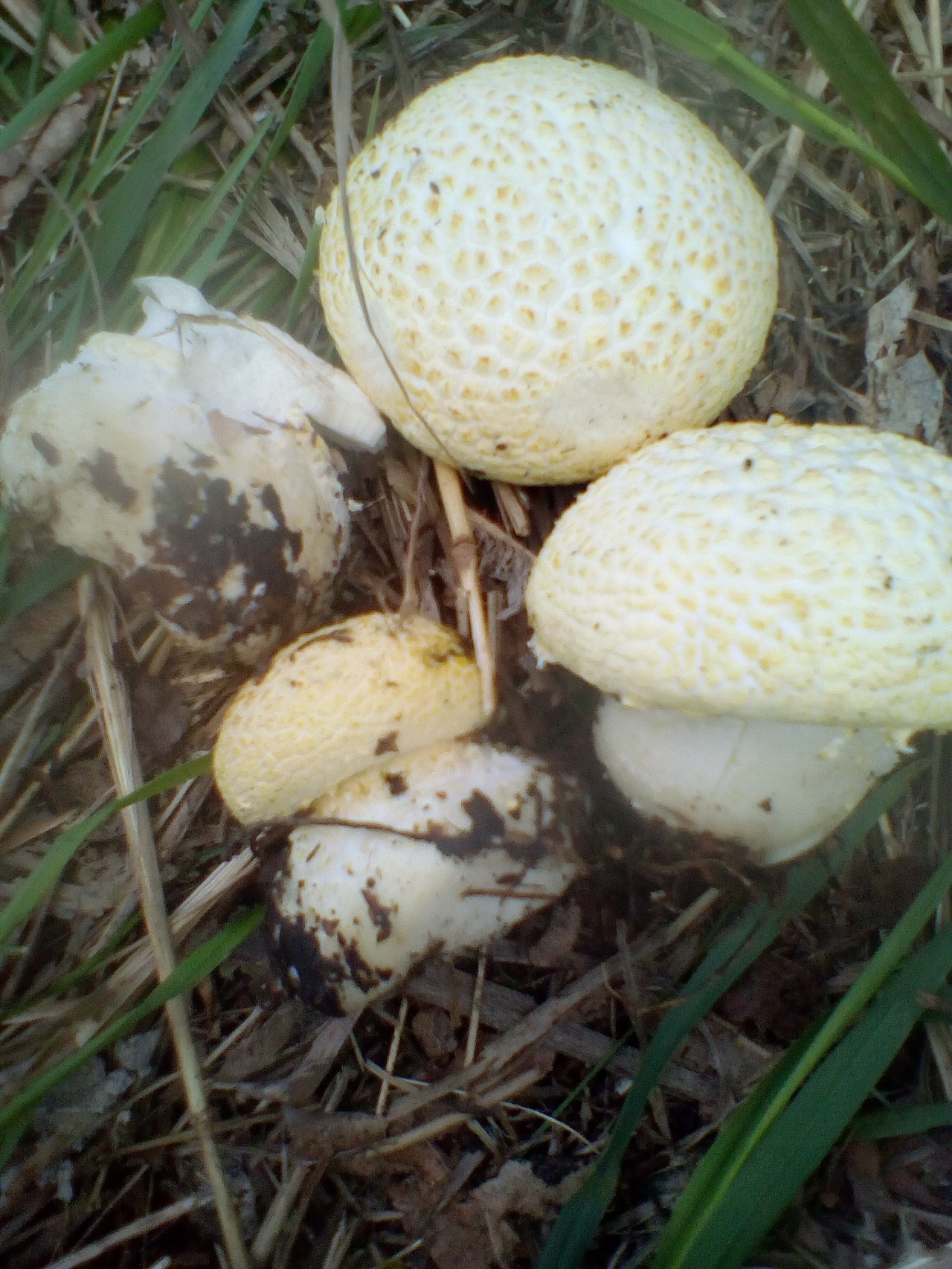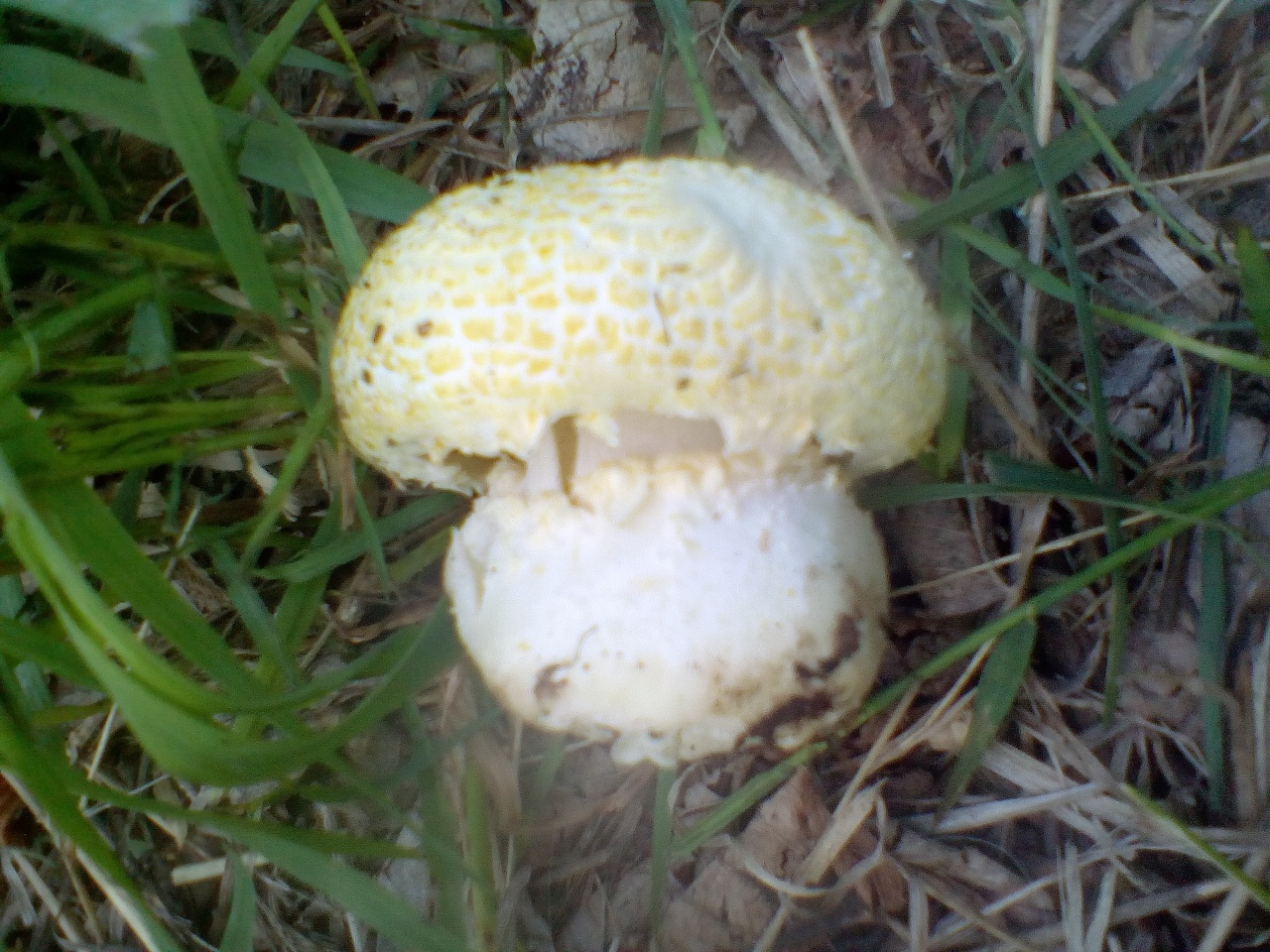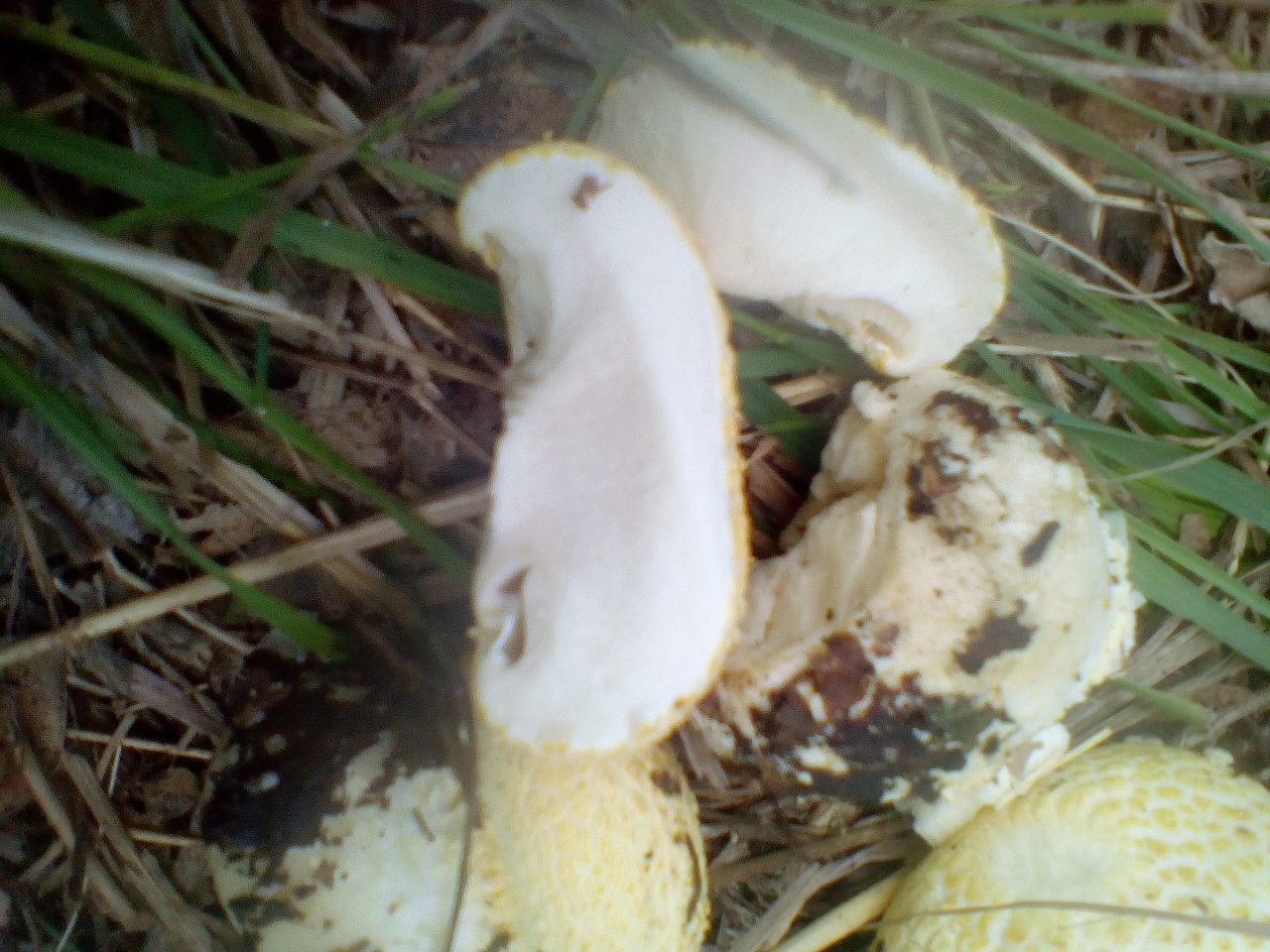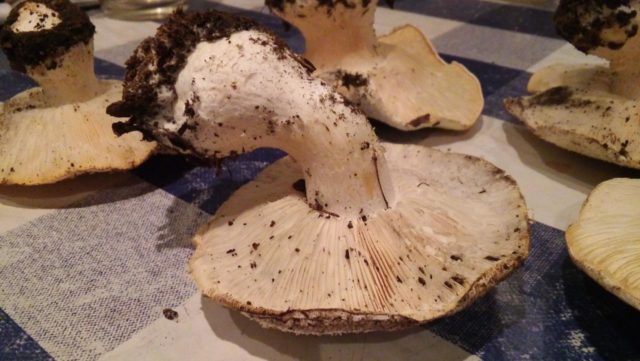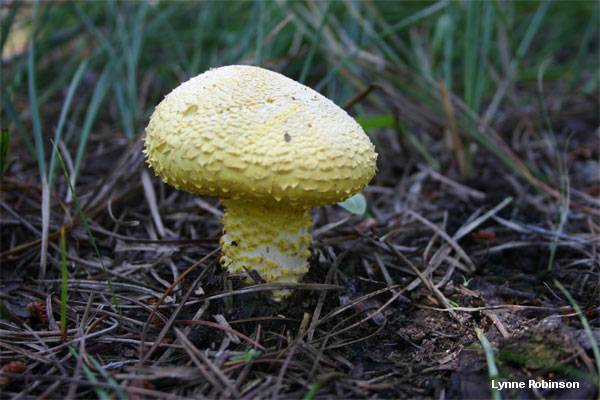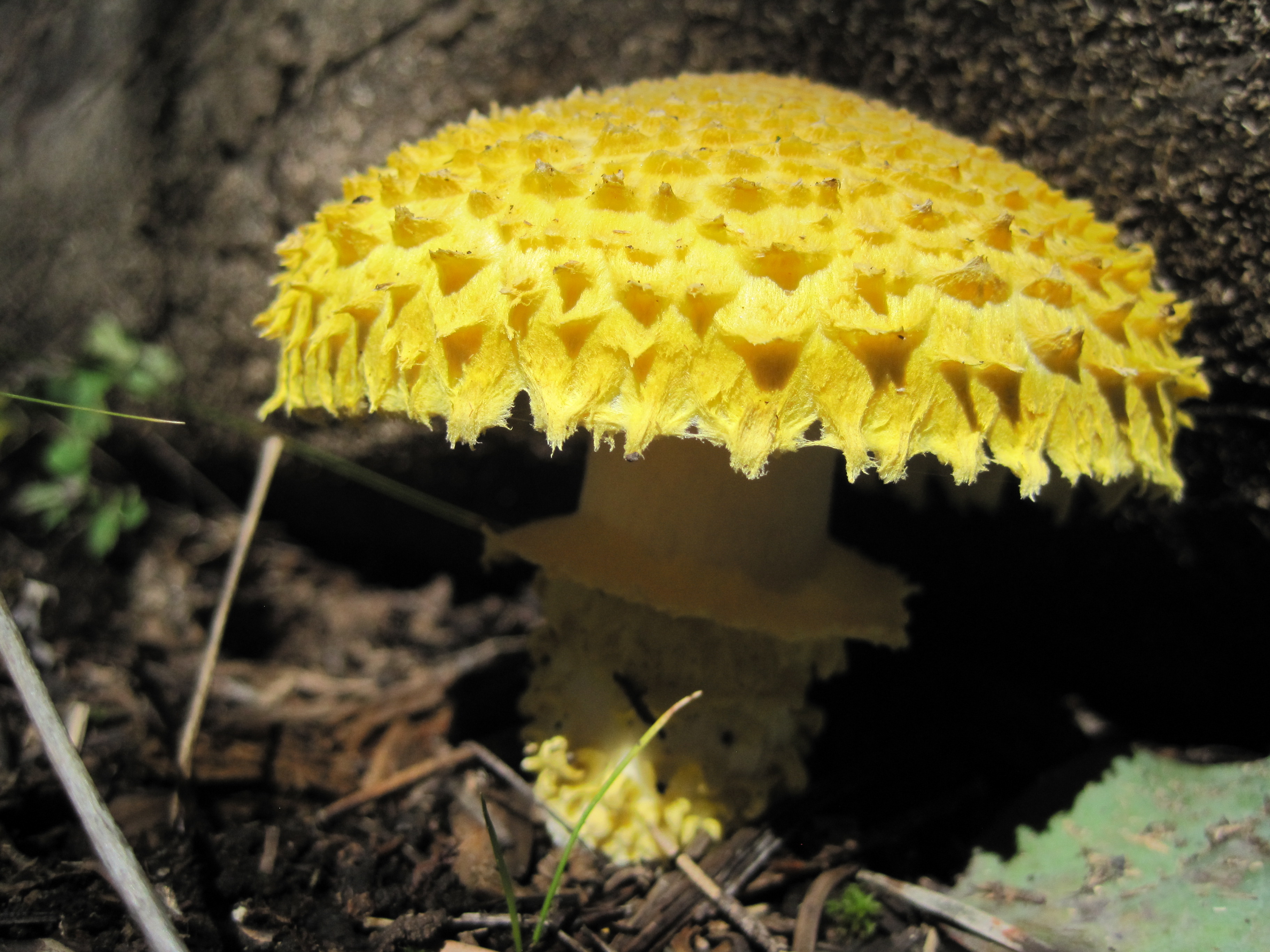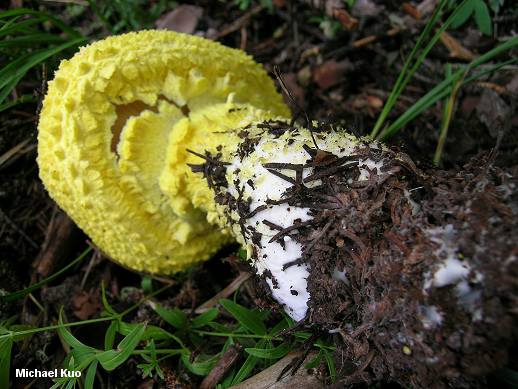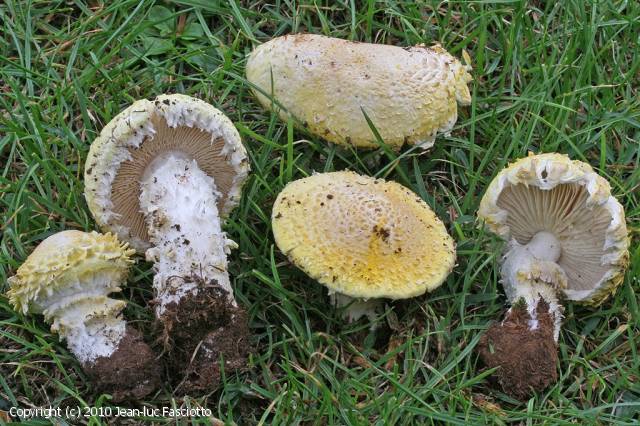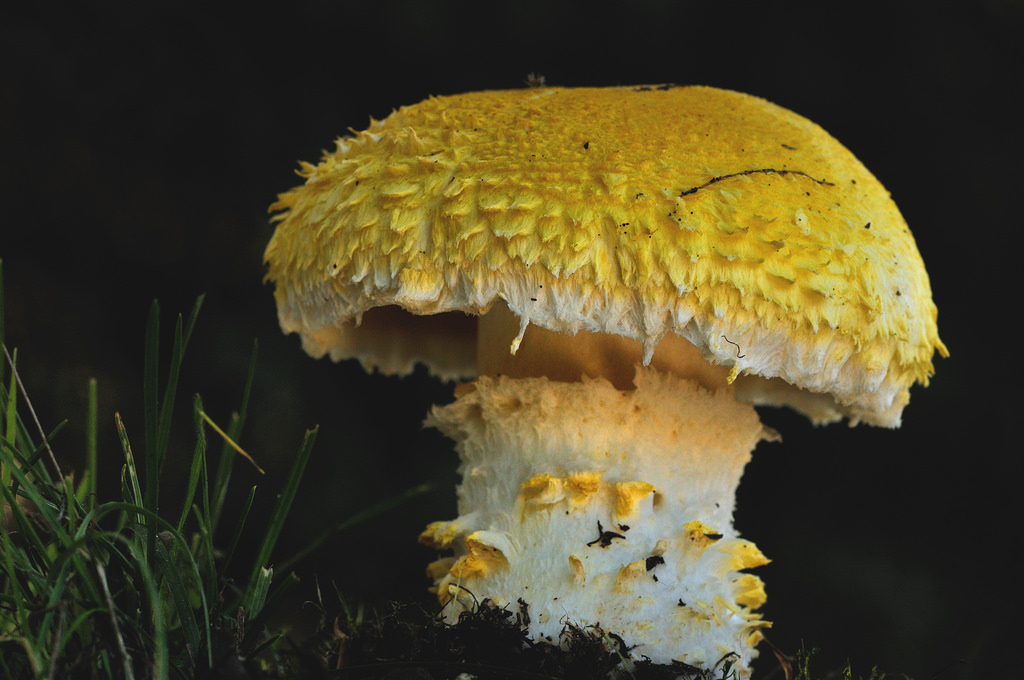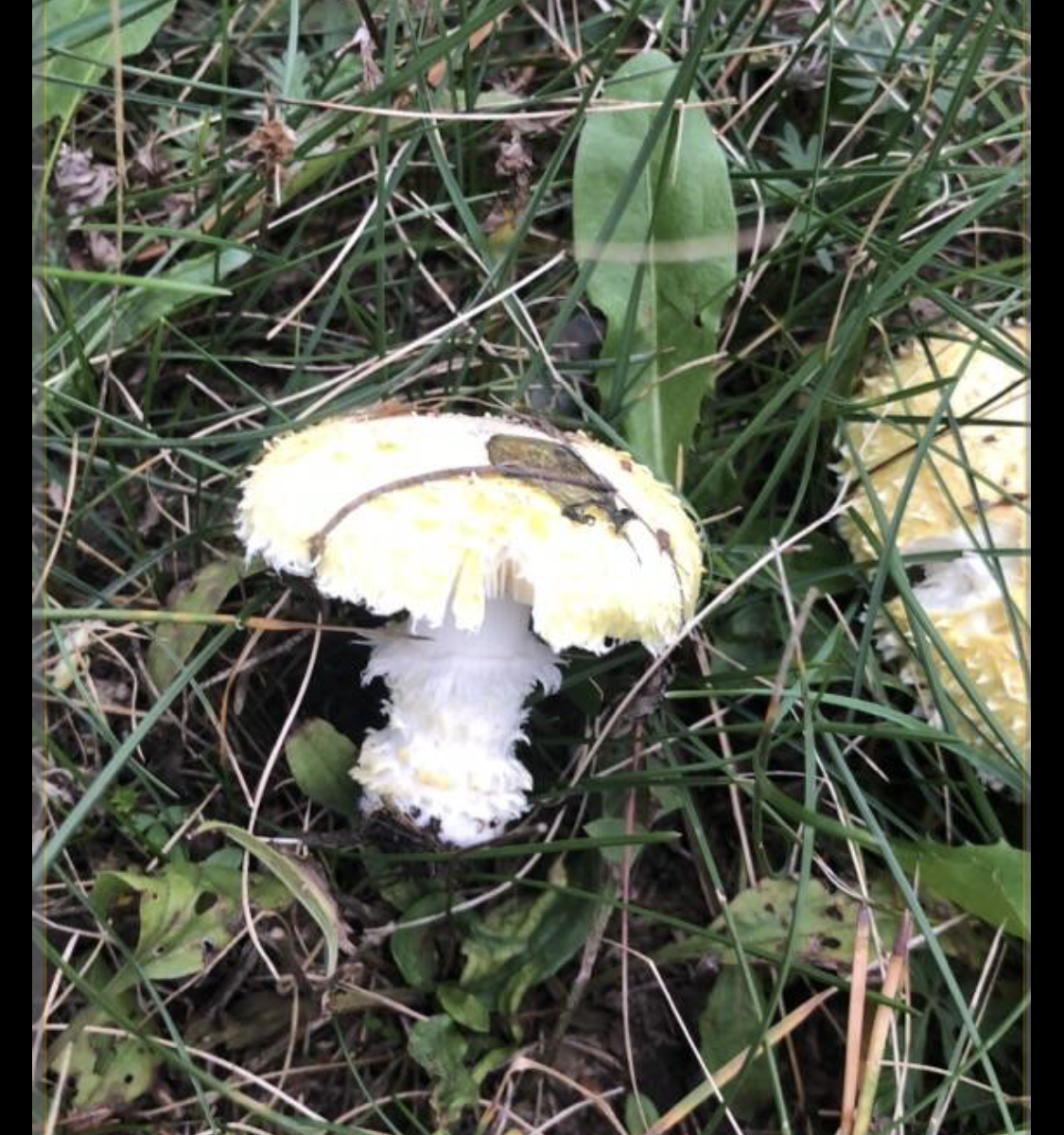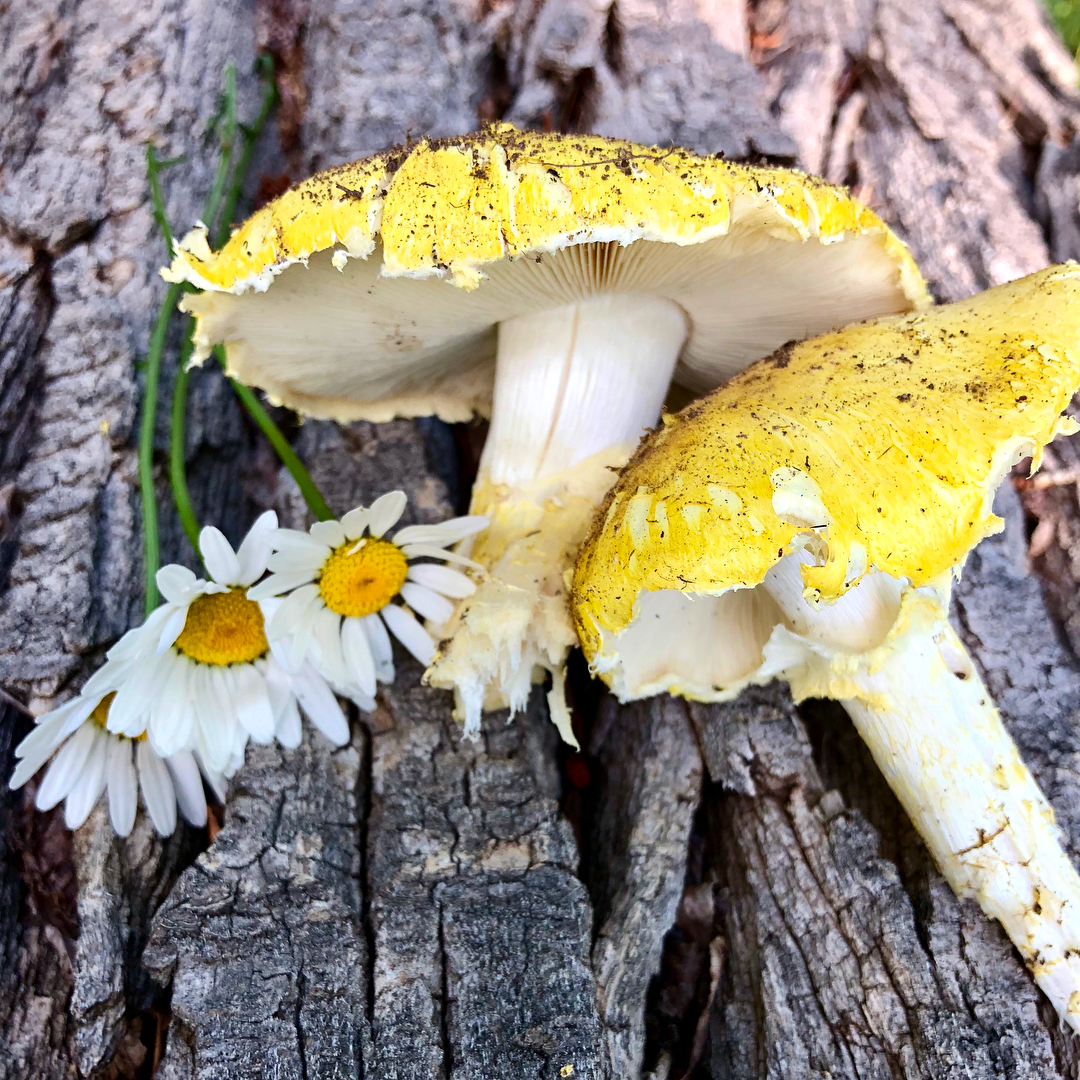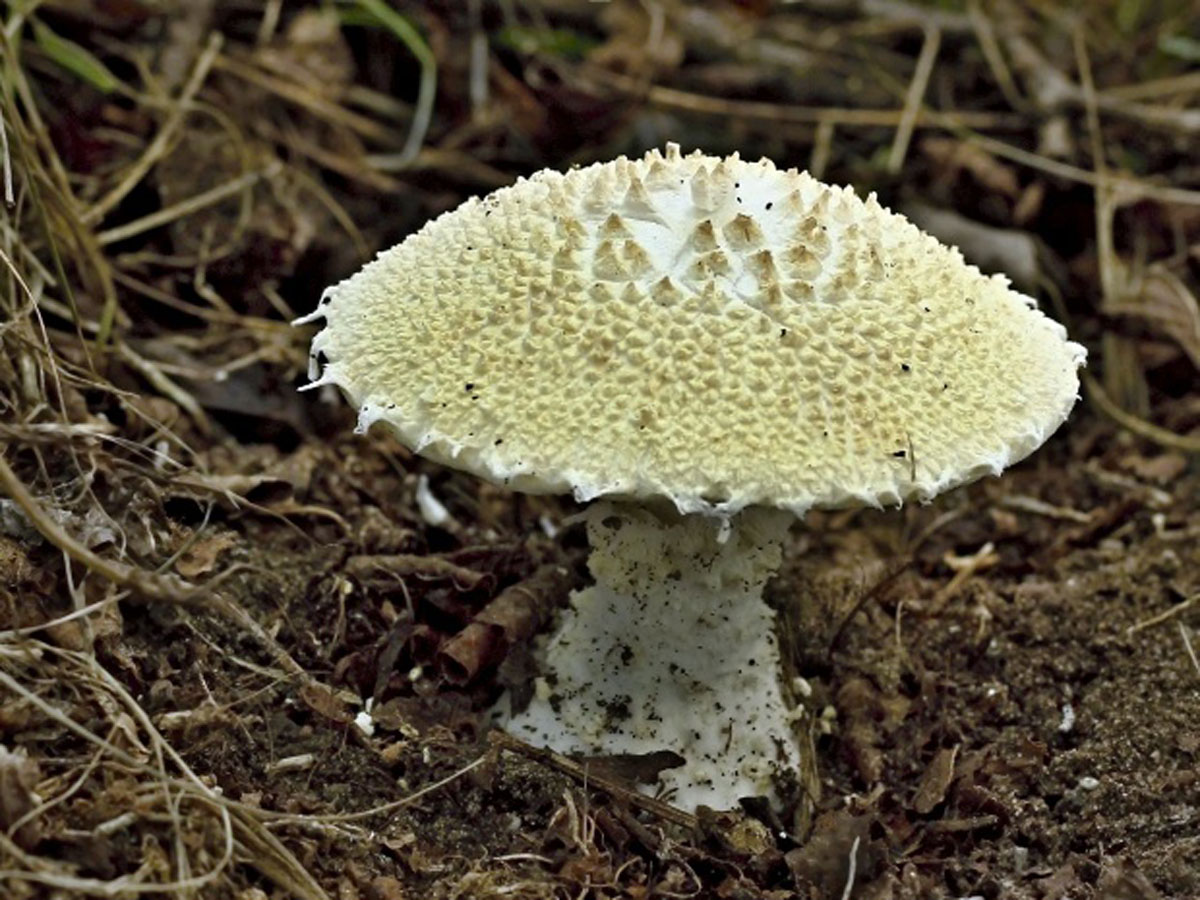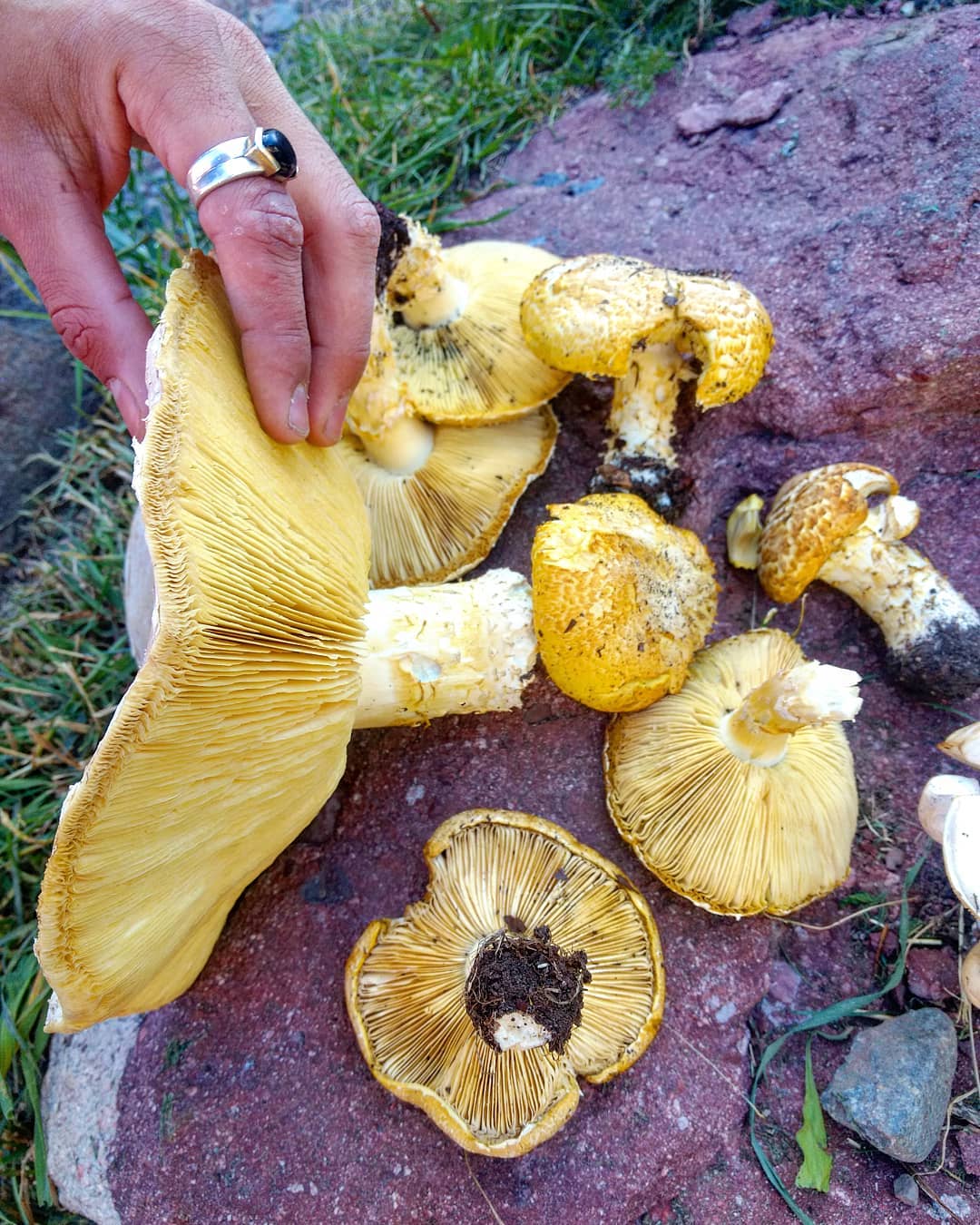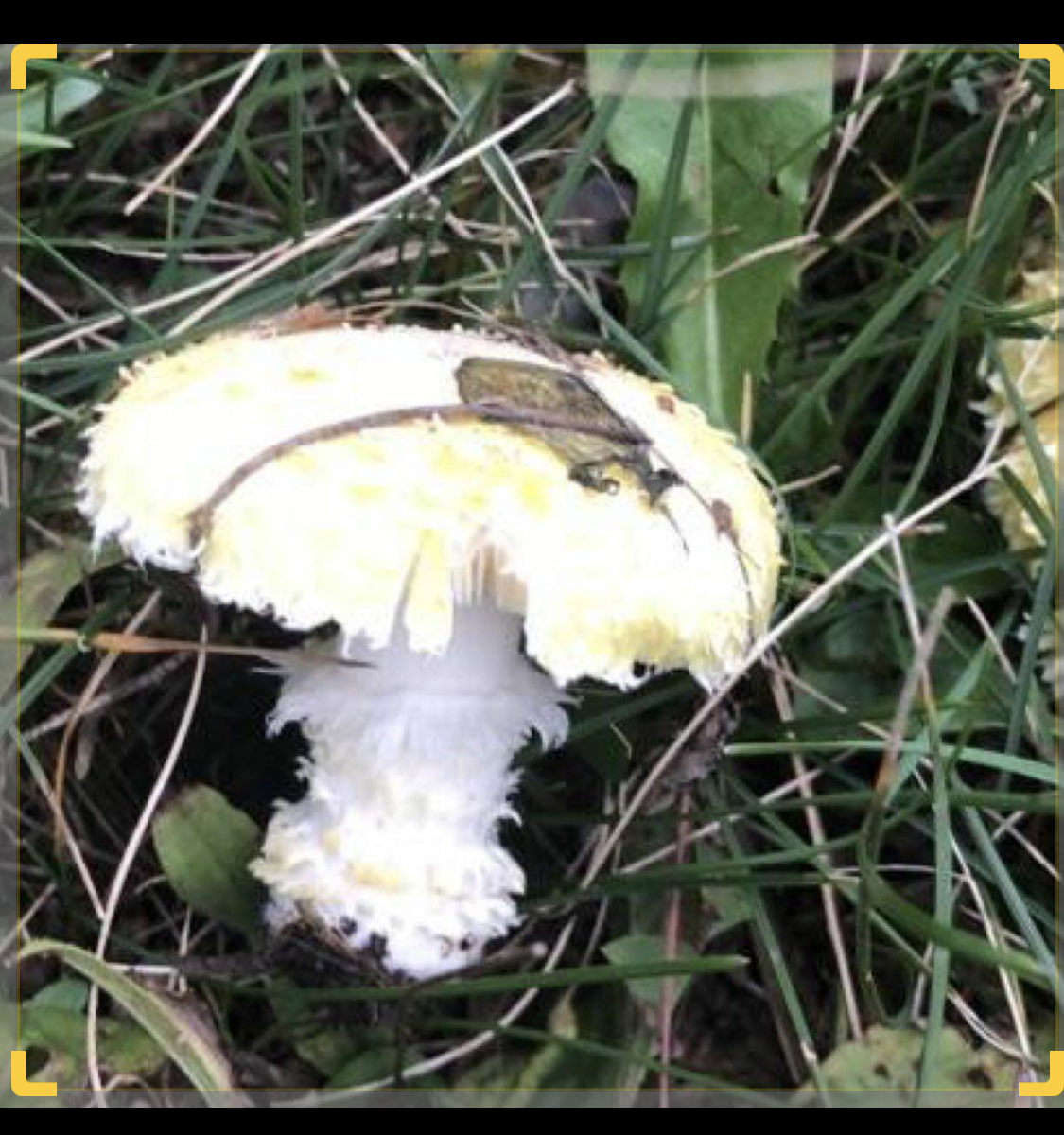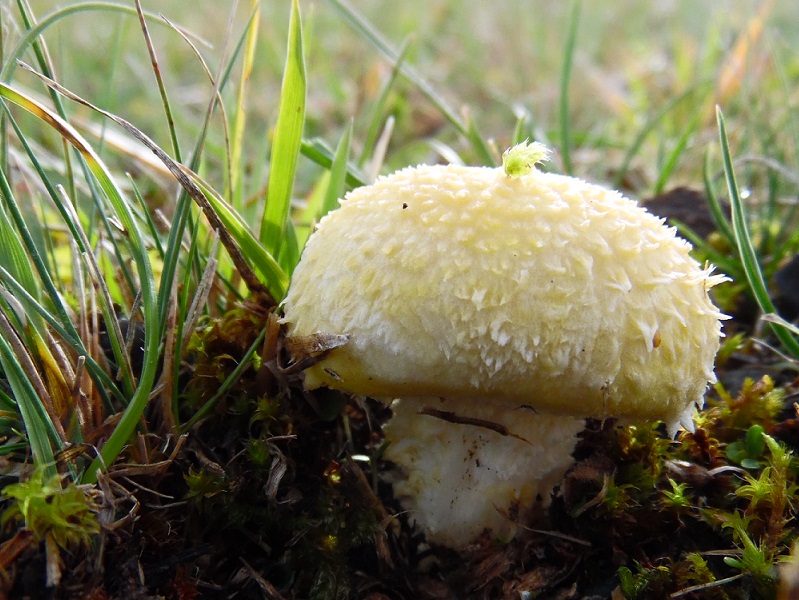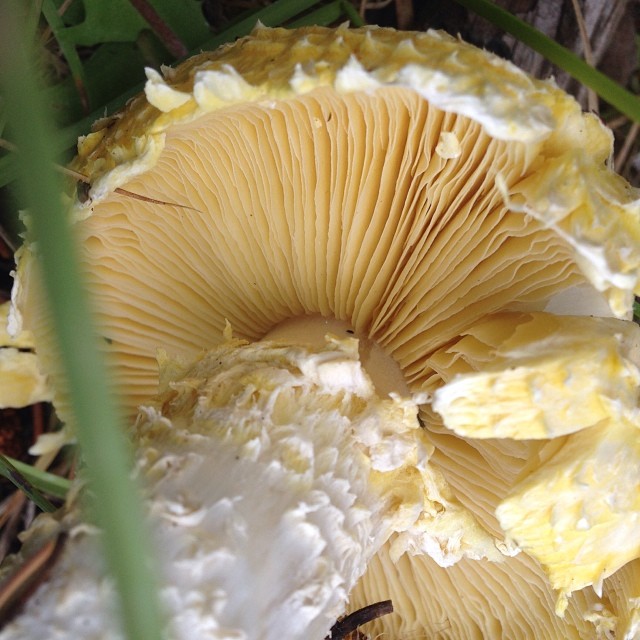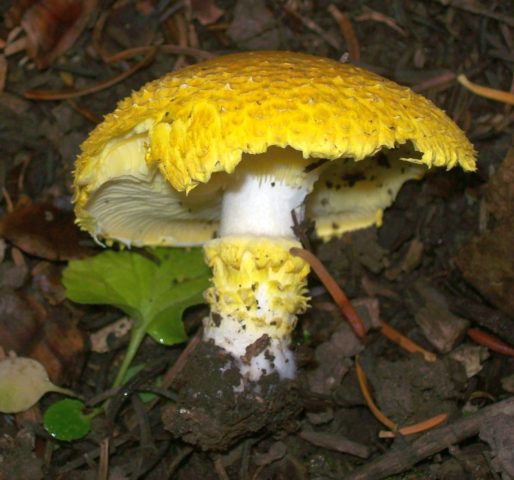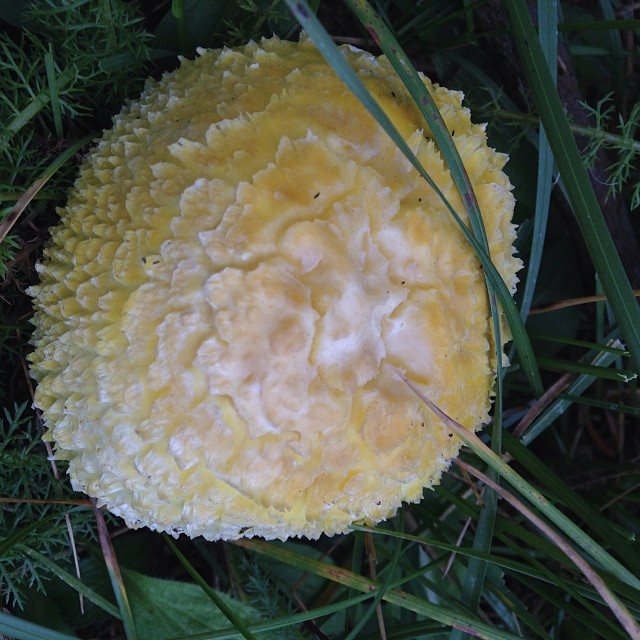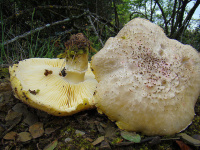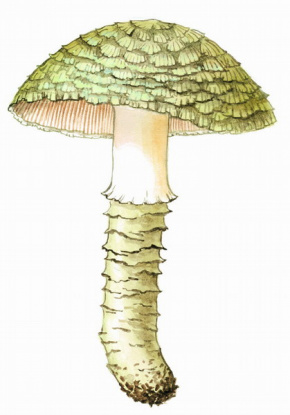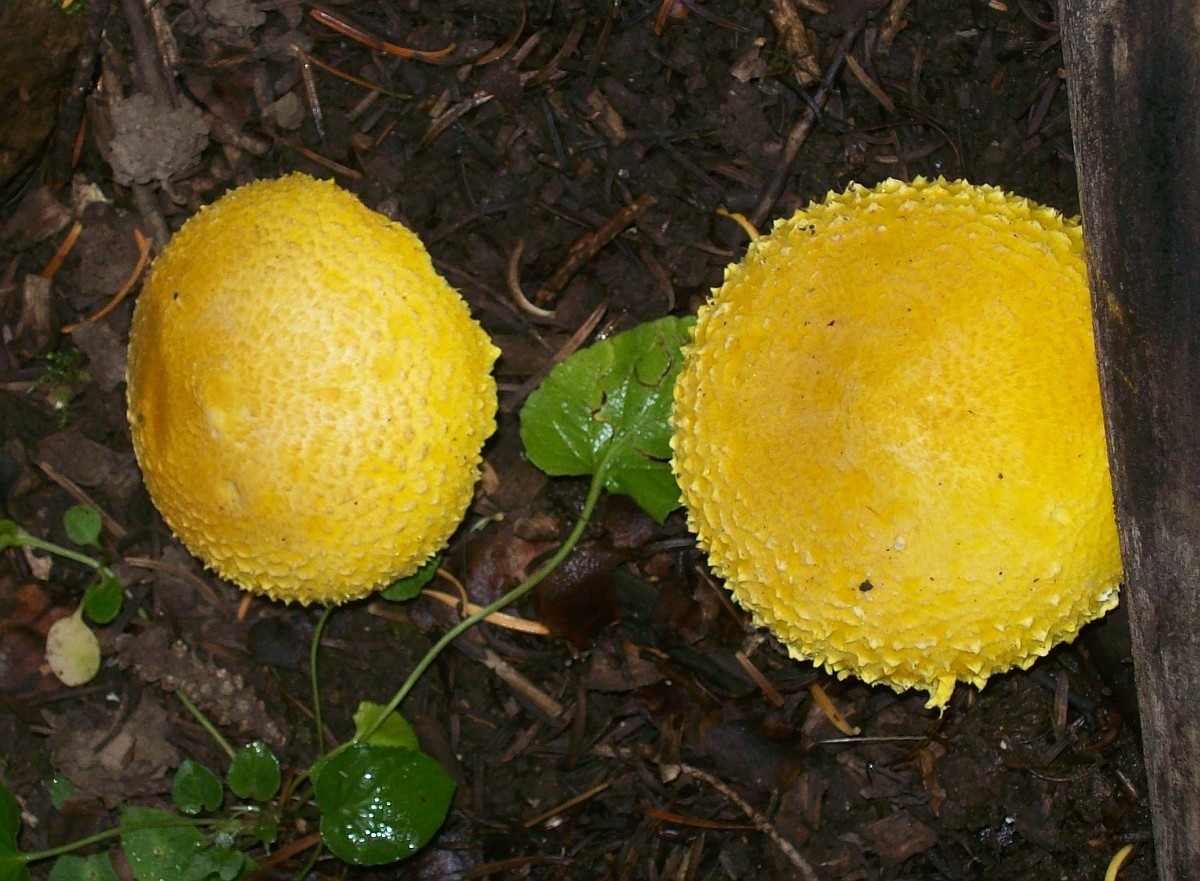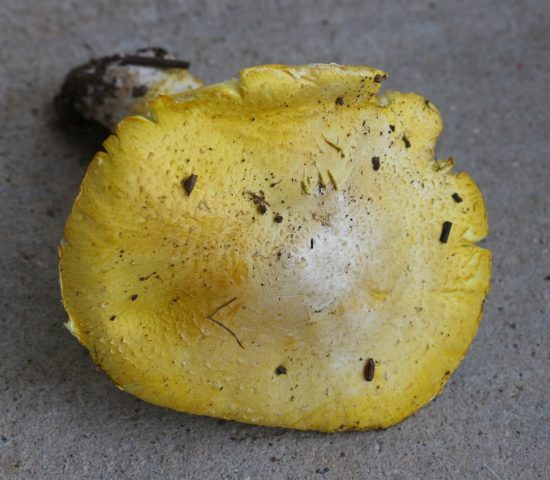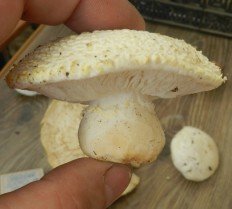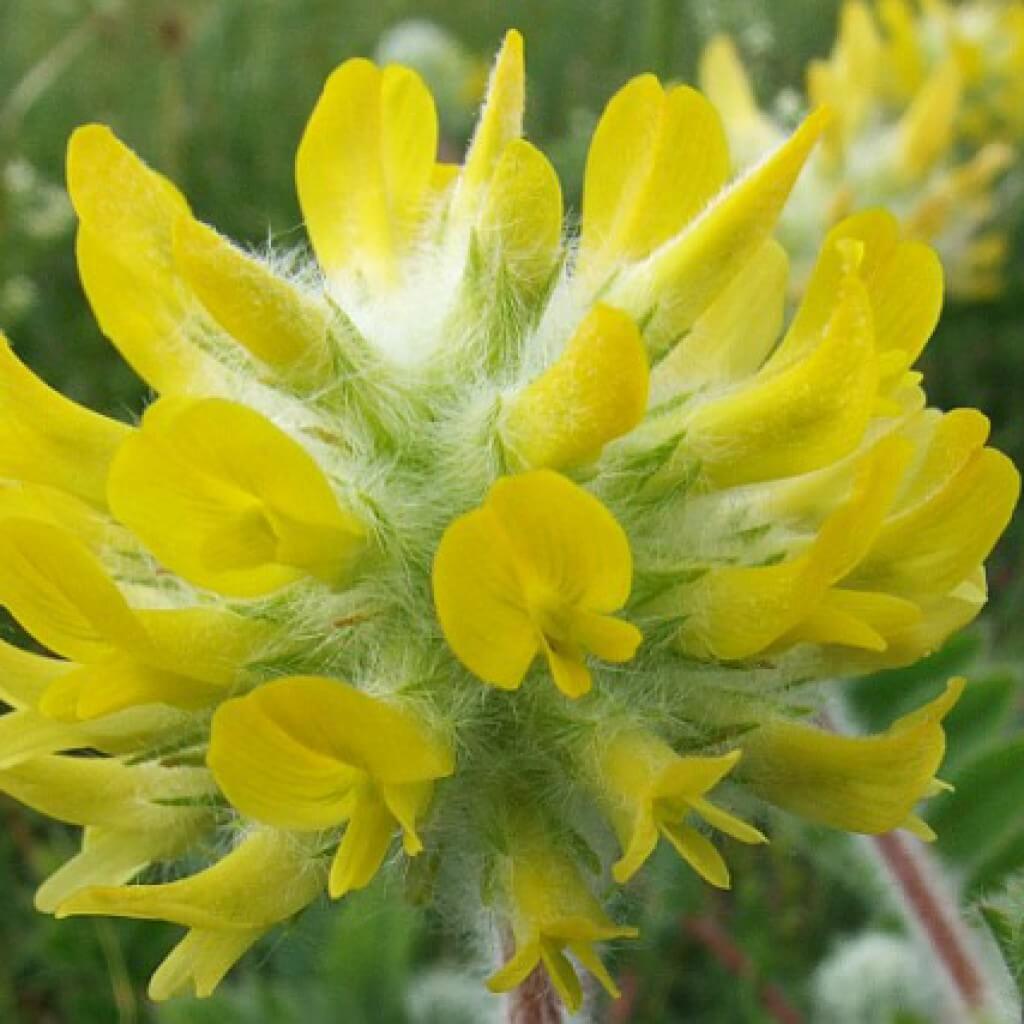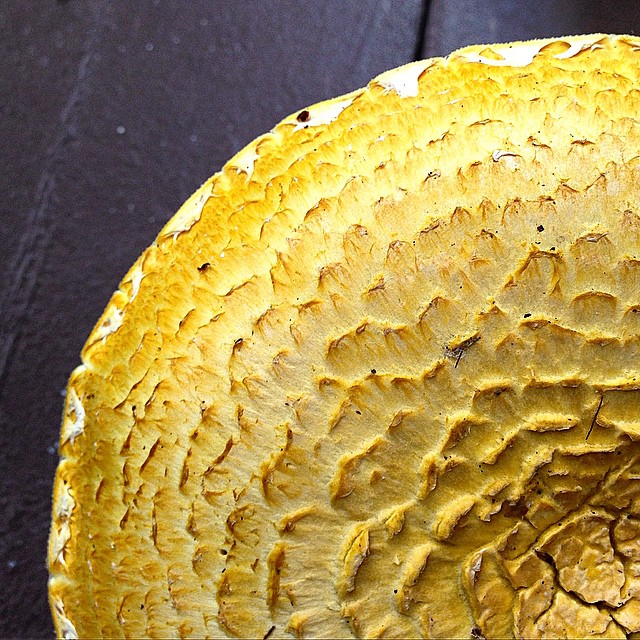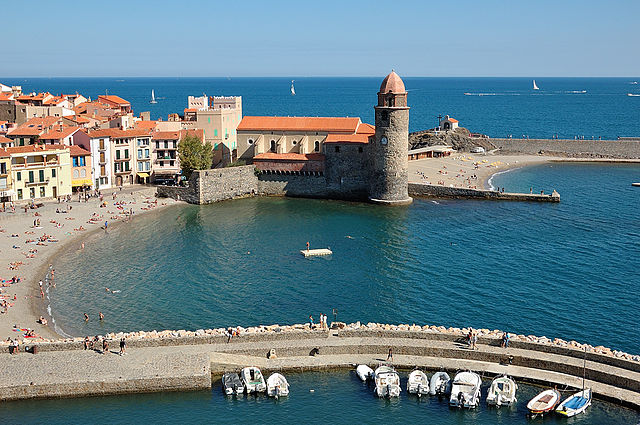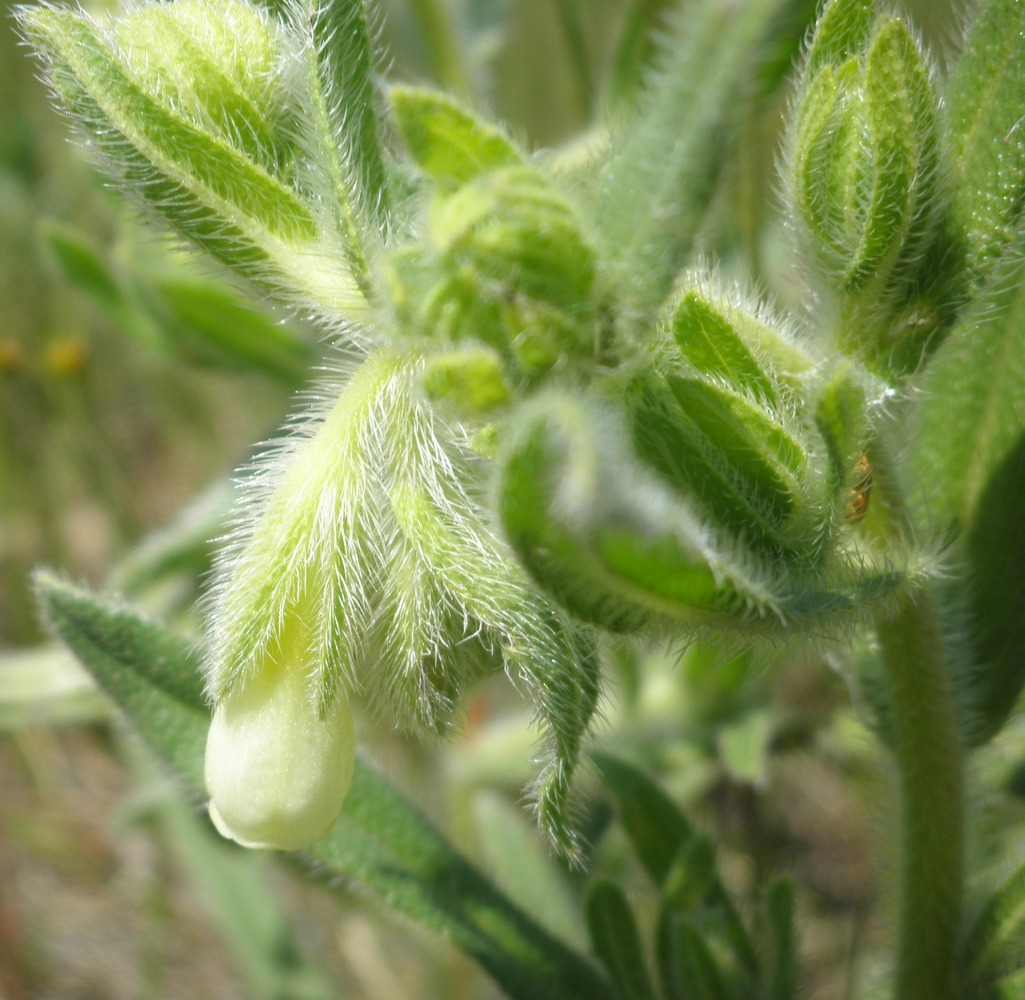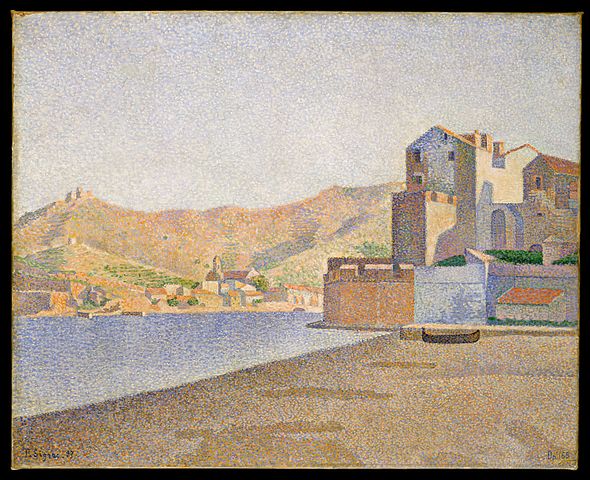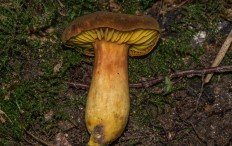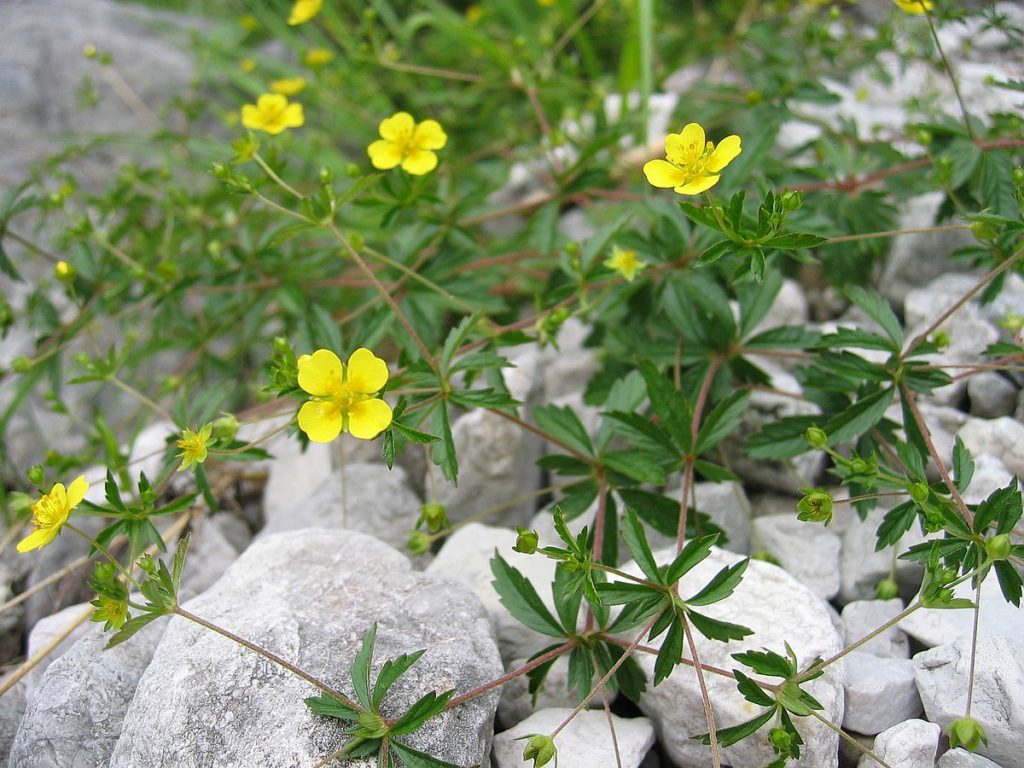Straw-yellow floccularia (Floccularia straminea, Floccularia straminea) what mushrooms look like, where
Straw-yellow floccularia (Straminea floccularia): photo and description
| Name: | Floccularia straw yellow |
| Latin name: | Floccularia straminea |
| View: | Edible |
| Synonyms: | Floccularia straminea |
| Systematics: |
|
Straw-yellow floccularia belongs to the category of unknown mushrooms of the Champignon family and bears the official name - Floccularia straminea. The species is on the verge of extinction as a result of fires, grazing and deforestation. Therefore, in many states, they are trying to grow it in artificial conditions.
What does floccularia straw yellow look like?
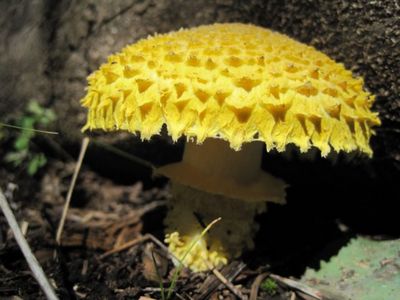
Straw-yellow floccularia is distinguished by its original shade, which significantly distinguishes it from the background of other mushrooms. It has a smaller size, a pleasant mushroom smell and a sweetish pulp.
Description of the hat
In young specimens, the cap has a convex spherical shape. However, as it develops, it becomes bell-shaped, outstretched, and sometimes flat. Its diameter can fluctuate in the range of 4-18 cm. On the surface, tightly fitting large fringed-type scales are frankly noticeable. From the very beginning, the color is bright yellow, but gradually it fades and becomes straw.
The fruit body has a fleshy, dense consistency. The upper shell is dry, matte. On the other side of the cap, there are plates that fit tightly together. From the very beginning, they are light, and then they acquire yellowness.
Leg description
At the break, the pulp is dense, the same shade of white. The length of the leg varies within 8-12 cm, and the thickness is 2.5 cm. Above, under the cap, the surface is smooth and light. At the bottom, at the very base, there are shaggy areas, on which yellow blankets of a soft consistency are frankly noticeable. Certain specimens have a groundless ring.
Where and how it grows
Straw-yellow floccularia prefers to grow in coniferous and mixed forests, under aspens and in spruce forests. It can also be found in the steppes. Grows singly and in groups.
Distribution zones in Russia:
- Altai Republic.
- West Siberian region.
- Far East.
- European part.
Plus, this mushroom grows in the states of Central and Southern Europe.
Doubles and their differences
One of the counterparts of straw-yellow floccularia is the edible Riken floccularia, which also belongs to the Champignon family. It grows mostly on the territory of the Rostov region. The main difference between the species is the external color. The double has a cream color. The rest of the mushrooms are very similar.
Straw-yellow floccularia in appearance also bears a resemblance to cotton wool psatirella, which should not be eaten. It is distinguished by a brown-scaly cap and a slender fruiting body. The plates on the other side are brown in color. The place of growth is the wood of deciduous trees.
Conclusion
Straw-yellow floccularia is a rare specimen that is of growing interest to craftsmen. Collecting it is of little value. And idle curiosity in this case can lead to its complete loss. Therefore, it is better to give preference to the more famous and delicious different types.
Straw yellow floccularia (Floccularia straminea)
Synonyms:
Floccularia straminea
Straw-yellow floccularia (Floccularia straminea) is a fungus belonging to the western variety of floccularia.
External description
Young straw-yellow floccularia mushrooms are characterized by a bright and rich color of the fruit body. The entire surface of the cap and legs of this species is covered with large soft scales. Fungal spores are starchy, and the plates are tightly attached to the surface of the fruiting body.
A hat with a diameter of 4 to 18 cm is characterized by a rounded and convex shape. However, this appearance is retained only in young fruit chalk. In ripe mushrooms, it takes on a wide bell-shaped, outstretched or flat, even shape. The surface of the cap of the straw-yellow floccularia is dry; it is noticeably covered with tightly attached scales. The bright yellow color of young fruiting bodies, as the mushrooms ripen, noticeably fade, becoming straw-yellow, pale yellow. Remnants of a partial cover can be seen around the edges of the cap.
The hymenophore is of the lamellar type, and the plates are very close to each other, fit tightly to the stem, and are characterized by a yellow or pale yellow color.
The stalk of the straw-yellow floccularia is characterized by a length of 4 to 12 cm, and its thickness is about 2.5 cm. It is more or less even in shape. Near the top, the leg is smooth, white. In the lower part, it has shaggy areas, consisting of yellow mushroom blankets of a soft structure. In some fruiting bodies, a flimsy ring can be seen near the cap. The color of the mushroom pulp is white. Spores are also characterized by a whitish (sometimes creamy) tint.
Regarding microscopic features, it can be said that spores in straw-yellow floccularia have a smooth structure, starchy and short in length.
Season and habitat of the mushroom
Straw yellow floccularia (Floccularia straminea) is a mycorrhizal fungus that can grow both singly and in large colonies. You can meet this species mainly in coniferous forests, in spruce forests and under aspens.
This type of mushroom grows near the Rocky Mountains on the western coast of Europe, and their active fruiting occurs during the period from summer to autumn. On the West Coast, straw-yellow floccularia can be seen even during the winter months. This type of mushroom belongs to the Western European species.
In addition to the Western Hemisphere, the species grows in the countries of southern and central Europe, preferring coniferous forests. Very rare or on the verge of extinction in Germany, Switzerland, Czech Republic, Italy, Spain.
Kreisel H. Global warming and mycoflora in the Baltic Region. Acta Mycol. 2006; 41 (1): 79- 94. states that with global warming, species boundaries are shifting to the Baltic region. However, no confirmed finds were found in Poland, Lithuania, Latvia, Estonia, Leningrad Region (RF), Kaliningrad Region (RF), Finland, Sweden, Denmark.
So it is very important that amateurs and professionals of the mushroom world from the above countries, including Germany, as well as the countries of southern, central Europe and Eurasia in general, share the findings of the species Floccularia straminea on the WikiMushroom website for a detailed study of places where such rare mushrooms grow
Edibility
Straw-yellow floccularia (Floccularia straminea) belongs to the edible mushrooms, but does not have a high nutritional value due to its small size. Beginners in the field of mushroom harvesting should generally avoid straw-yellow floccularia, as they can often be confused with some varieties of amanita.
Similar types and differences from them
Externally, the floccularia of struma is very similar to some types of poisonous fly agarics, therefore, when collecting it, mushroom pickers (especially inexperienced ones) should be very careful.
Other information about the mushroom
Regarding the taxonomic designation of the described species, it should be noted that this type of fungi is characterized by a serious taxonomic disorder.Initially, the western variety of this mushroom was described under the name of the true mushroom luteovirens, but in 1976 two mycological scientists, Smith and Mitchell, carefully studied the description and taxonomy of this mushroom and, based on the results obtained, concluded that the original descriptions did not belong to the named species.
Caring for a nocturnal garden
Growing nocturnal in open soil is quite simple, like most other horticultural crops. Watering should be carried out regularly, while after it and after rain, it is sometimes necessary to loosen the soil surface. After the appearance of weeds, it must be removed immediately, and the bushes are systematically fed. In some cases, due to heavy inflorescences, the stems bend to the surface of the soil, which makes the bushes less attractive. In this case, you will need to install supports, to which the shoots are tied.
Experts advise cutting off the inflorescences immediately after they wither. This culture needs shelter only if a very frosty and little snow winter is expected. The plantings should be covered with non-woven material (lutrasil or spunbond). Spruce paws can also be used to cover the site.
How to water and feed
Watering such flowers is necessary on average 1 time in 7 days, for this they use warm water heated in the sun. During prolonged dry and sultry periods, the frequency of watering should be increased. At the same time, during prolonged rains, watering is suspended, since if the soil is excessively wet all the time, this significantly increases the likelihood that earthen fleas will harm the bushes, since they like to settle on crops belonging to the Cabbage family. It is necessary to water and loosen the soil surface only in the morning.
During the first season, the flowers are regularly fed with a solution of a complex mineral fertilizer, which contains a large amount of nitrogen. In the second year, during the period of bud formation, the plant should be fed with liquid complex fertilizer for flowering plants or phosphorus and potassium fertilizers.
Propagation of nocturnal
Species and varieties with simple flowers can be propagated by seed. But if terry night violets are cultivated, then they are propagated exclusively by dividing the bush, since if you independently collect seeds from the bushes and sow them, then the grown plants will have simple flowers. The division of bushes of terry varieties is carried out at the beginning of the spring period or in the autumn. To do this, the bush is carefully removed from the ground, divided into several parts, and the cuts are processed with crushed charcoal. Then the delenki are planted in pits, which are prepared in advance.
In late autumn, before the first frosts, the soil surface near the plants must be covered with a layer of mulch, which will save the root system from severe frosts in a winter with little snow.
Nocturnal pests and diseases
The night violet is affected by the same diseases and harmful insects as the rest of the Cruciferous family. Such a flower can be harmed by cabbage aphids, cruciferous fleas and bugs, cauliflower stem moth, cabbage moth, caterpillars of turnip and cabbage whiteflies and cabbage scoops, larvae of rape sawfly and cabbage fly and cruciferous gall midge. Insecticides are used to kill harmful insects; they can be bought at a specialized store. Experts advise trying to find a product that effectively destroys pests, while not harming the environment.
During the seedling period, seedlings can get sick with a black leg. An older plant sometimes infects keela, peronosporosis, alternaria, sclerotinia, phomosis, botrytis and fusarium, they are also fungal diseases. Also, the night violet can be struck by such bacterial diseases as black rot and vascular bacteriosis.For this culture, viral diseases such as mosaic and ring spot are very dangerous, since today they are considered incurable. In the fight against fungal diseases, fungicides show high efficiency, the choice of which in specialized stores is quite wide. However, those bushes that are affected by viral or bacterial diseases must be removed from the soil and destroyed as soon as possible. The area where the affected bushes were grown for three or four years will not be suitable for growing a single crop.
However, if you adhere to the rules of prevention and provide the plants with proper care, then they will be highly resistant to both harmful insects and diseases.
Botanical description
Agrostis straminea C. Hartm. 1819, Gen. Gram. Scand .: 4; Tsvelev, 1964, Arct. fl. USSR, 2: 46; Peshkova, 1990, Fl. Siberia, 2: 111; Cherepanov, 1995, Vessel. rast. Russia and contributor. state : 655. -A. Stolonifera subsp. straminea (C. Hartm.) Tzvel. 1971, Syst. higher. rast. 8: 58; Probatova, 1976, News sist. higher. rast. 13:33; Tsvelev, 1976, Cereals of the USSR: 332. - A. stolonifera var. arenaria Jans. et Wacht. 1940, Nederl. Kruidk. Arch. 50: 113. -A. Maritima auct. non Lam .: Shishkin, 1934, Fl. USSR, 2: 185. - Straw yellow bent.
Rast. (6) 10-25 (40) cm h. Many L. Art. numerous, usually at the base b. m. ascending; often there are well-developed stolon-like creeping sterile bastards. L. 2-8 cm long. and up to 2.5 mm wide., flat or folded lengthwise, gradually pointed. Language. upper Art. l. 1-3 mm long., Obtuse. Met. 2-10 cm long., Numerous, small, oblong-linear, sometimes spike-shaped, very dense, narrow (up to 1.5 cm wide.), With slightly rough from scattered spines (often almost smooth) vet. Qty. (2) 2.3-3.5 mm long, dark purple. Qty. Czech almost equal to each other. Lower color Czech awnless, less often with a short (up to 1 mm long) almost straight spine extending into the upper. third Czech (of the number is not issued). Upper color Czech 2-3 times shorter than lower. color Czech Dusty. (1) 1.2-1.4 (1.5) mm long
North-Sakh. (Sakhalin, Okhinsky district, Moskalvo settlement, in a swamp by the sea, 1968, T.I. Nechaeva - VLA, LE). - Skid. On sands and pebbles, swampy meadows of the sea coast. - Common. Dist .: Heb. h., Zap. Sib .; Scand., Wed Heb. (sowing). - Described from Sweden.
Ricken's floccularia (Floccularia rickenii) what mushrooms look like, where and how they grow, are they edible or not
Floccularia Ricken: photo and description
| Name: | Riken's floccularia |
| Latin name: | Floccularia rickenii |
| Type of: | Edible |
| Synonyms: | Armillaria rickenii, Ripartitella rickenii |
| Systematics: |
|
Ricken's floccularia (Floccularia rickenii) is a lamellar mushroom of the Champignon family, has a limited growing area, partially covering the territory of the Rostov region. The species is protected as rare and poorly studied; work is underway to search for new populations. It has no other names.
What does Ricken's floccularia look like?
Floccularia rickenii is a medium-sized mushroom with a sweetish pulp that has a pleasant mushroom smell. The structure of the fruit body is dense, the flesh is white, when interacting with air, the color at the break does not change.
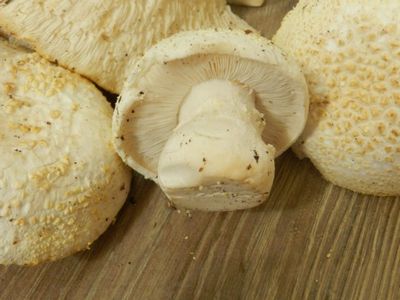
Description of the hat
The average diameter of the cap is from 3 to 8 cm, some specimens reach 12 cm. At a young age, the cap is fleshy, thick, hemispherical. As it grows, it opens up, becoming prostrate-convex. The surface of the cap is dry, without gloss, with characteristic small warts. These are the remnants of a velum (common blanket) that protects the fruiting body at a young age. Each wart has three to eight facets, with a diameter ranging from 0.5 to 5 mm. When dry, warty growths are easily exfoliated.
The edges of the cap are first bent, then straight, often have fragments of the coverlet. The color of the cap changes from white to cream with age. The center is much darker than the edges and is painted in a straw-grayish or gray-lemon shade.
The reverse side is covered with thin white plates located close to each other and descending to the pedicle. In older mushrooms, the plates acquire a lemon-cream color.
Microscopic spores are colorless, shaped like a wide oval or ball. The surface of the spores is smooth, sometimes with an oil droplet.
Leg description
The color of the leg is identical to the color of the cap. Height - on average from 2 to 8 cm, diameter - 15-25 mm. The stalk of Ricken's floccularia has the shape of a cylinder; there is a very noticeable thickening in the lower part. At the base, the pedicle is covered with small layered warts - about 0.5-3 mm. The top is bare. Young specimens have a ring that quickly disappears as they grow.
Is the mushroom edible or not
Riken's floccularia is edible. The data on the palatability are contradictory: in some sources the species is described as tasty, in others - with low palatability.
Where and how it grows
Riken's floccularia is a rare mushroom listed in the Red Data Book of the Rostov Region. On the territory of Russia, it can be found only in the suburb of Rostov-on-Don (in the forest belt of the Chkalov farm), in the vicinity of the Ulyashkin farm in the Kamensky district and in the Schepkinsky forest massif of the Aksaysky district. There are also recorded cases of finding this species in the Volgograd region.
Ricken's floccularia grows in other countries as well:
Prefers to settle in artificial plantings of white acacia, thickets of heditsia and common robinia. Fruit bodies are located on the soil, often in sandy massifs of deciduous forests, grow in small groups. Floccularia Ricken loves the neighborhood with Tatar maple and pine, but does not form mycorrhiza with them. Fruiting from May to October.
Doubles and their differences
In some cases, Ricken's floccularia can be confused with its closest relative - straw-yellow floccularia (Floccularia straminea). Another name is Straminea Floccularia. The main difference between the two types is the yellow color of the cap. Floccularia straminea is an edible mushroom with mediocre taste, growing mainly in the coniferous forests of Western Europe.
Conclusion
Riken's floccularia is a rare species in Russian forests, more interesting for specialists than for ordinary mushroom pickers. In order to preserve and further spread this representative of Champignon, you should refrain from collecting in favor of more familiar and tasty varieties.
Ricken floccularia Floccularia rickenii (Bohus) Wasser [Armillaria rickenii Bohus]
Taxonomic affiliation: Family Ryadovkovy - Tricholomataceae.
Conservation status of the species: Vulnerable.
Scientific significance: A rare species with a disjunctive range.
The area of the species and its distribution in Ukraine: Europe. In Ukraine, it is known from the Right-Bank and Left-Bank cereal-meadow steppe, as well as the Right-Bank and Left-Bank cereal Steppe. Adm. regions: Dn, Od, Nk, Xs.
Number and structure of populations: It happens singly and in groups, sometimes in large.
Reasons for the change in numbers: Livestock grazing, fires, deforestation.
Growing conditions: Artificial plantations of white acacia (Robinia pseudoacaciа) and natural groups of Tatar maple (Acer tataricum) on sands, on soil.
General biomorphological characteristics A hat with a diameter of 7-12 cm, thick, fleshy, first hemispherical, then convex-outstretched, dry, matte, covered with concentrically located cone-shaped 3-8-sided warts (remnants of a common blanket) 0.5-5 mm in size, easily exfoliate when dry , the edge of the cap is bent, subsequently straight, often with remnants of the veil. At first, the cap is white, with time it is creamy white, dark in the middle, grayish straw-yellow, pale lemon-grayish. The plates are adherent, sometimes slightly descending on the stem, thin, thick, first white, then pale cream with a lemon tint. Spores 4.0-5.5 × 3.0-4.0 μm, broadly oval, sometimes almost spherical, somewhat pointed towards the base, smooth, colorless, often with a drop of oil. Spore powder, cream.The leg is 2-4 × 0.6-0.8 cm, central, cylindrical, with a tuber-like base widened to 2-4 cm, naked at the top, below it is covered with the remains of a common bedspread in the form of layered warts 0.5-3 mm in size, which the upper part of the leg form a vague ring that quickly disappears. The pulp is dense, white, does not change at the break, with a pleasant mushroom smell, the taste is sweet. There are buckles. Fruiting bodies appear in June-October.
Population conservation regime and protection measures: Protected in the Dnieper-Orel PZ. It is necessary to create botanical reserves in other localities of the species and isolate it into a pure culture.
Reproduction and breeding in specially created conditions: There is no information.
Economic and commercial value: Soil-forming. Edible mushroom.
Mushroom Bloody Tooth
A mysterious and unique representative of the mushroom kingdom is the Bloody Tooth mushroom, which got its name from its unusual appearance. It was first written about it in 1913, although it was discovered much earlier, back in 1812. Interestingly, scientists have not yet fully studied its properties.
Appearance (description)
Some representatives of nature on our planet surprise and horrify. These include the extraordinary mushroom "bloody tooth". It is found in coniferous forests in the European and North American territory.
It's hard not to pay attention to this mushroom, because its bright color immediately attracts the eye.
The name "Gidnellum Peck" was given after the name of the mycologist from the USA Peck, who first discovered this species. The size of the mushroom is average, the cap is slightly more than 5 cm in diameter, similar to chewed gum with a delicate strawberry smell, the leg is about 2 cm high. On the surface of the cap, bright blood drops appear, as if it is stained with the blood of a wounded animal. This red liquid is produced by the fungus itself through the pores. "Hydnellum peckii" is somewhat similar to boletus with wedge or currant juice spilled on it. The body is white, velvety, turns brown with aging.
The main characteristic of the "bloody tooth" is the absorption of water from the soil and feeding on small insects that accidentally fall into it. The word "tooth" appeared in the title for a reason. When "Hydnelum Peka" grows, pointed formations appear along its edges.
Edible or not?
"Gidnellum Peka" refers to the order of Agaricales, however, unlike the same champignons, it is not edible. The fruit body does not contain poison, the danger comes only from the pigment in the cap (atromentin). Its toxicity is still being studied and it is not yet known whether it is fatal to humans. The mushroom tastes bitter - it needs it to scare away people and animals.
Where and when does the Bloody Tooth mushroom grow?
As we said above, this mushroom grows in the coniferous forests of Australia, Europe and North America. In the Russian Federation, you can see it extremely rarely and only in the autumn season from September to November. Not so long ago, it was discovered in Iran, North Korea and the Komi Republic.
Mr. Summer resident: the healing properties of a bloody tooth
In the course of the study, scientists found that the mushroom juice contains a substance atromentin, which is a specific anticoagulant. It can be used to prevent blood clots and improve blood clotting. It is also believed that the use of a tincture of alcohol and a bright poisonous liquid of the mushroom helps heal bruises, since the latter has pronounced antibacterial properties.
Some doctors hope that in the near future a drug will be created on the basis of the purple substance, akin to penicillin, which was obtained from the mushroom of the same name.
Similarities with other species
The mushroom has close relatives:
- Rusty Hydnellum (Hydnellum ferrugineum). It can be easily distinguished from a "bloody tooth" with aging, initially a white body with liquid red drops in shade begins to resemble rust.
- Blue Hydnellum (Hydnellum caeruleum). Grows near white mosses in the forests of Northern Europe. On its pulp, the same bloody drops stand out, and it is distinguished by its distinct blue color. With aging, the center of the cap turns brown.
- Odorous Hydnellum (Hydnellum suaveolens).The light fruiting body with blue thorns darkens with aging, has a pungent odor. No red liquid is released.
Description
The cap is convex to flattened (sometimes with a shallow umbo), measuring 5–12 cm (2.0–4.7 in) in diameter. Its color is bright-yellow to orange-yellow and then later brownish, and it has flattened brownish scales over the center. The whitish cap margin is rolled inward. The well-separated gills have tooth-like edges, and an adnate attachment to the stipe, sometimes with a notch. They are initially white before turning cream in maturity. The stipe measures 3–8 cm (1.2–3.1 in) long by 1–2.5 cm (0.4–1.0 in) wide, and is roughly the same width throughout. Shiny with a light yellow-brown base color, it has one to several cottony zones of partial veil remnants. The flesh is firm, and white to yellow under the cap cuticle. It has no distinguishable odor and a mild taste.F. albolanaripes mushrooms are edible.
The spore print is white. Spores are ellipsoid, smooth, and measure 6–8 by 4–4.5 µm.
Similar species
The base form of species Floccularia luteovirens is similar in appearance, but can be distinguished from F. albolanaripes by its brighter yellow cap color with raised scales on the surface, and yellowish gills.F. luteovirens forma straminea (which has sometimes been defined as a distinct species, F. straminea) is another lookalike with similar coloration and habitat preferences, but its cap features shaggy scales arranged in concentric zones, and it has light yellow gills.

